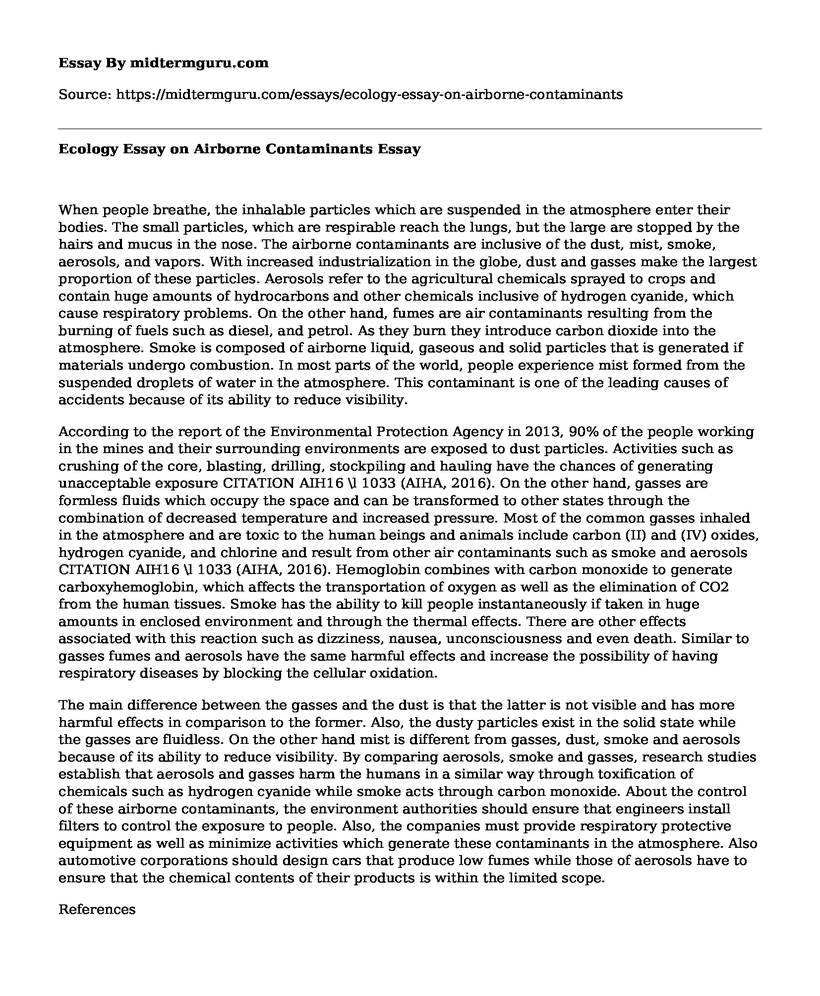When people breathe, the inhalable particles which are suspended in the atmosphere enter their bodies. The small particles, which are respirable reach the lungs, but the large are stopped by the hairs and mucus in the nose. The airborne contaminants are inclusive of the dust, mist, smoke, aerosols, and vapors. With increased industrialization in the globe, dust and gasses make the largest proportion of these particles. Aerosols refer to the agricultural chemicals sprayed to crops and contain huge amounts of hydrocarbons and other chemicals inclusive of hydrogen cyanide, which cause respiratory problems. On the other hand, fumes are air contaminants resulting from the burning of fuels such as diesel, and petrol. As they burn they introduce carbon dioxide into the atmosphere. Smoke is composed of airborne liquid, gaseous and solid particles that is generated if materials undergo combustion. In most parts of the world, people experience mist formed from the suspended droplets of water in the atmosphere. This contaminant is one of the leading causes of accidents because of its ability to reduce visibility.
According to the report of the Environmental Protection Agency in 2013, 90% of the people working in the mines and their surrounding environments are exposed to dust particles. Activities such as crushing of the core, blasting, drilling, stockpiling and hauling have the chances of generating unacceptable exposure CITATION AIH16 \l 1033 (AIHA, 2016). On the other hand, gasses are formless fluids which occupy the space and can be transformed to other states through the combination of decreased temperature and increased pressure. Most of the common gasses inhaled in the atmosphere and are toxic to the human beings and animals include carbon (II) and (IV) oxides, hydrogen cyanide, and chlorine and result from other air contaminants such as smoke and aerosols CITATION AIH16 \l 1033 (AIHA, 2016). Hemoglobin combines with carbon monoxide to generate carboxyhemoglobin, which affects the transportation of oxygen as well as the elimination of CO2 from the human tissues. Smoke has the ability to kill people instantaneously if taken in huge amounts in enclosed environment and through the thermal effects. There are other effects associated with this reaction such as dizziness, nausea, unconsciousness and even death. Similar to gasses fumes and aerosols have the same harmful effects and increase the possibility of having respiratory diseases by blocking the cellular oxidation.
The main difference between the gasses and the dust is that the latter is not visible and has more harmful effects in comparison to the former. Also, the dusty particles exist in the solid state while the gasses are fluidless. On the other hand mist is different from gasses, dust, smoke and aerosols because of its ability to reduce visibility. By comparing aerosols, smoke and gasses, research studies establish that aerosols and gasses harm the humans in a similar way through toxification of chemicals such as hydrogen cyanide while smoke acts through carbon monoxide. About the control of these airborne contaminants, the environment authorities should ensure that engineers install filters to control the exposure to people. Also, the companies must provide respiratory protective equipment as well as minimize activities which generate these contaminants in the atmosphere. Also automotive corporations should design cars that produce low fumes while those of aerosols have to ensure that the chemical contents of their products is within the limited scope.
References
BIBLIOGRAPHY \l 1033 AIHA. (2016). Hazards: Chemicals and Materials. Retrieved from www.aiha.org/publications-and-resources
Cite this page
Ecology Essay on Airborne Contaminants. (2021, Jun 07). Retrieved from https://midtermguru.com/essays/ecology-essay-on-airborne-contaminants
If you are the original author of this essay and no longer wish to have it published on the midtermguru.com website, please click below to request its removal:
- To Frack or Not to Frack - Ecology Essay Sample
- Air Pollution in the World and Its Effects - Essay Example
- Research Paper on Global Warming and the Effect on Crop Production
- Research Paper on Marine Plastic Waste
- Environmental Pollution and Degradation - Essay Sample
- Animal Testing in Pharmacy - Essay Sample
- Coal: A Vital Source of Power & the Impact of Environmental Regulations - Essay Sample







